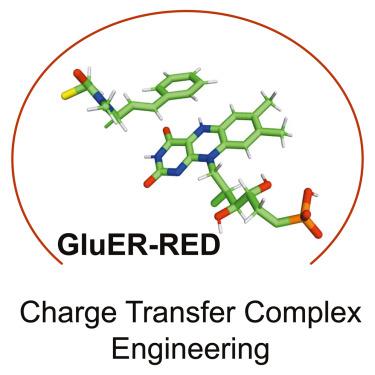Our official English website, www.x-mol.net, welcomes your
feedback! (Note: you will need to create a separate account there.)
Engineering a photoenzyme to use red light
Chem ( IF 19.1 ) Pub Date : 2024-10-16 , DOI: 10.1016/j.chempr.2024.09.017 Jose M. Carceller, Bhumika Jayee, Claire G. Page, Daniel G. Oblinsky, Gustavo Mondragón-Solórzano, Nithin Chintala, Jingzhe Cao, Zayed Alassad, Zheyu Zhang, Nathaniel White, Danny J. Diaz, Andrew D. Ellington, Gregory D. Scholes, Sijia S. Dong, Todd K. Hyster
Chem ( IF 19.1 ) Pub Date : 2024-10-16 , DOI: 10.1016/j.chempr.2024.09.017 Jose M. Carceller, Bhumika Jayee, Claire G. Page, Daniel G. Oblinsky, Gustavo Mondragón-Solórzano, Nithin Chintala, Jingzhe Cao, Zayed Alassad, Zheyu Zhang, Nathaniel White, Danny J. Diaz, Andrew D. Ellington, Gregory D. Scholes, Sijia S. Dong, Todd K. Hyster

|
Photoenzymatic reactions involving flavin-dependent “ene”-reductases (EREDs) rely on protein-templated charge transfer (CT) complexes between the cofactor and substrate for radical initiation. These complexes typically absorb in the blue region of the electromagnetic spectrum. Here, we engineered an ERED to form CT complexes that absorb red light. Mechanistic studies indicate that red-light activity is due to the growth of a red-absorbing shoulder off the previously identified cyan absorption feature. Molecular dynamics simulations, docking, and excited-state calculations suggest that the cyan feature involves a π→π∗ transition on flavin, whereas the red-light absorption is a π→π∗ transition between flavin and the substrate. Differences in the electronic transition are due to changes in the substrate-binding conformation and allosteric tuning of the electronic structure of the cofactor-substrate complex. Microenvironment tuning of the CT complex for red-light activity is observed with other engineered photoenzymatic reactions, highlighting this effect’s generality.
中文翻译:

设计光酶以使用红光
涉及黄素依赖性“烯”还原酶 (ERED) 的光酶反应依赖于辅因子和底物之间的蛋白质模板电荷转移 (CT) 复合物进行自由基起始。这些复合物通常在电磁波谱的蓝色区域吸收。在这里,我们设计了一个 ERED 来形成吸收红光的 CT 复合物。机制研究表明,红光活性是由于先前确定的青色吸收特征的红光吸收肩部的生长。分子动力学模拟、对接和激发态计算表明,青色特征涉及黄素上的π→π∗转变,而红光吸收是黄素和底物之间的π→π∗转变。电子跃迁的差异是由于底物结合构象的变化和辅因子-底物复合物电子结构的变构调整。与其他工程光酶反应一起观察到 CT 复合物的红光活性微环境调节,突出了这种效应的普遍性。
更新日期:2024-10-16
中文翻译:

设计光酶以使用红光
涉及黄素依赖性“烯”还原酶 (ERED) 的光酶反应依赖于辅因子和底物之间的蛋白质模板电荷转移 (CT) 复合物进行自由基起始。这些复合物通常在电磁波谱的蓝色区域吸收。在这里,我们设计了一个 ERED 来形成吸收红光的 CT 复合物。机制研究表明,红光活性是由于先前确定的青色吸收特征的红光吸收肩部的生长。分子动力学模拟、对接和激发态计算表明,青色特征涉及黄素上的π→π∗转变,而红光吸收是黄素和底物之间的π→π∗转变。电子跃迁的差异是由于底物结合构象的变化和辅因子-底物复合物电子结构的变构调整。与其他工程光酶反应一起观察到 CT 复合物的红光活性微环境调节,突出了这种效应的普遍性。

































 京公网安备 11010802027423号
京公网安备 11010802027423号